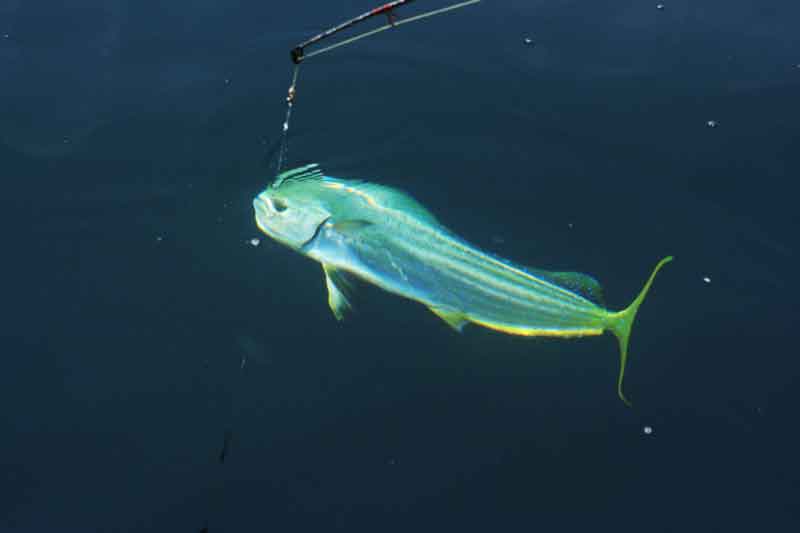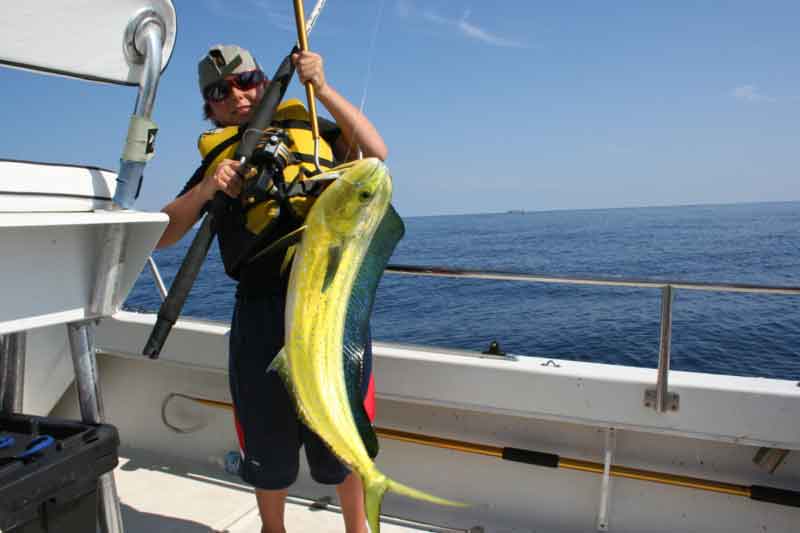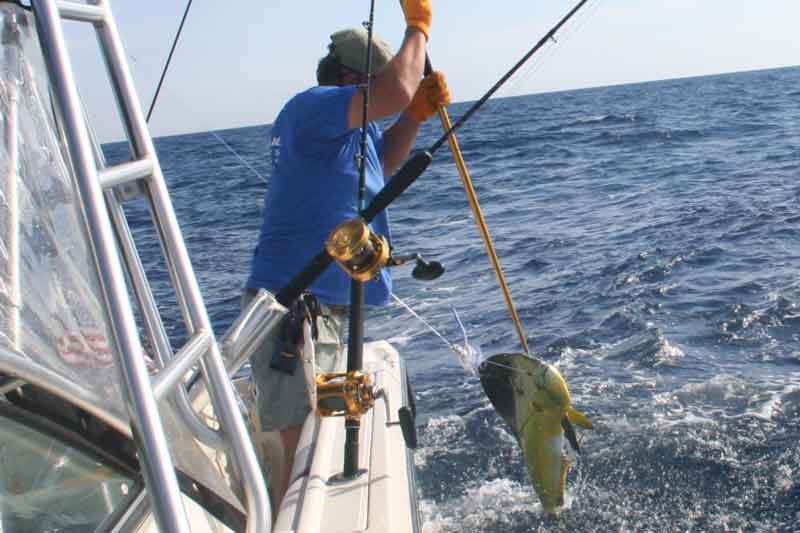Mahi-mahi, otherwise known as Dolphinfish, travel in schools and can be found offshore but often wander closer to the shore in the summer—making them a popular inshore fishing target—during the summer months by both beginner and experienced fishermen. While they may not be found in the Chesapeake Bay, they are common when you go out of Indian River, the Ocean City inlet, Virginia Beach, and other Mid-Atlantic sea ports throughout the region. While an adventure to their abode can be a trek for some, the trip is worth it as the fish will be sure to provide a great photo opportunity—as it boasts beautiful colors—and is delicious to eat. Mahi-mahi is lean and has a mild to sweet flavor that is enjoyed by many throughout the summer months.

Mahi-mahi, members of the Actinopterygii family, are found throughout the Atlantic, Indian, and Pacific oceans. They prefer a water temperature of around 82 degrees but can be found in water as low as 68 degrees. While it is believed that the fish are highly migratory, there is little known about the extent of their migration patterns. A tagging program throughout the Atlantic coast has allowed scientists to affirm the previously held belief that these fish migrate long distances in short amounts of time. Young mahi-mahi are most common near the coast lines whereas mature mahi-mahi are more commonly found in greater depths of water. In addition, it has been found that they only live for around five years and can reach full maturity within four to five months. These fish typically spawn on the east coast from April through July. When you head out for your big fishing adventure to catch mahi-mahi, make sure you are ready to catch the speedy fish that can swim anywhere from 50 to 57 knots. Check out our recent fishing reports to see where mahi-mahi have been spotted throughout the region.
Mahi-mahi Identification
Mahi-mahi can be identified by the following characteristics:
- The front of the head has a bony crest
- Bright blue, gold and yellow sides with a yellow underside
- Dorsal fin from eye to caudal fin
- Long pectoral fin that is more than half of head length
Mahi-mahi Regulations
States along the Atlantic coast have different fishing regulations in place for the length and bag limit of mahi-mahi.
- Maryland does not hold a minimum size limit and the season is open year-round, however, there is a daily limit of 10 per person or a boat limit of 60. While there is this bag limit, it only applies to federal waters.
- Virginia holds both a size limit and a bag limit, and requires mahi-mahi to be at least 20 inches and with the bag limit at 10 per day.
- Delaware holds the same regulations as Maryland.
Record Mahi-mahi
Maryland’s state record for mahi-mahi was caught out of Ocean City by Kristy Frashure in August 2019 when she reeled in a massive 74.5-pound catch in the Poor Girls Fishing Tournament. Frashure caught the record-setter off of Poor Man’s Canyon, taking nearly 20 to 30 minutes to reel onto the boat. Virginia’s state record for mahi-mahi is close, at 71.8 pounds. Delaware’s state record for mahi-mahi was caught out of Indian River Marina by William Emmert in July 2014 when he caught a 56.9-pound fish at the tip of Baltimore Canyon on the Elizabeth Jane.
Best Mahi-mahi Baits
Fishermen throughout the region have had the best luck catching mahi-mahi with:
- Ballyhoo
- Cut fish of all varieties
- Squid

Best Mahi-Mahi Lures
Anglers can catch dolphinfish while trolling or casting lures, as well as using bait. Some top offerings include:
- Diving plugs
- Soft plastic jigs
- Artificial squid
- Spreader bars
- Daisy chains
Mahi-Mahi Fishing Tackle
Mahi-mahi are strong fish and often take a lot of effort when reeling onto the boat. Therefore, fishermen suggest using tackle that will last and also to bring back-up tackle just in case it breaks. A seven-foot heavy action rod with a 30 to 50 pound braided or fused line and lure weights up to one ounce are good for casting. In addition, it is recommended to have a 50 pound barrel swivel. Leader size can range from 30 to 80 pound flourocarbon and when using bait circle hooks of 6/0 to 9/0 are common.
When trolling, fishermen should use 30 to 50 pound class rods and reels. Rigs should include a 7/0 to 9/0 hook for ballyhoo, when setting out their offerings. Oftentimes when fishing for mahi-mahi, fishermen will hook other strong oceanic fish unintentionally, therefore it is important to have a rod and line that is intended to last.
Popular Techniques for Mahi-Mahi Fishing
Mahi-mahi are often drawn to floating objects such as weeds, boards, or commercial fishing gear floats at or near the surface of the water. Many bait fishermen take advantage of this in their venture to catch mahi-mahi, and find success by tossing out their bait next to floating seaweed. When attracting the interest of a group of mahi-mahi—they travel in schools—it is important to keep a bucket of chum or fish chunks aboard to keep the group’s interest. This tactic is called bailing for mahi-mahi.
On many boats, fishermen like trolling for dolphinfish. Fishermen can target areas of floating seaweed or commercial fishing gear floats, and mahi-mahi are also attracted to commotion on the water, such as boats. That’s one of the reasons why fishermen have found success using spreader bars and daisy chains, as they make commotion, catching the attention of the school of fish.

Best Places to Fish for Mahi-Mahi
As a general rule of thumb all of the canyons off the Mid-Atlantic coast hold dolphinfish when the water is warm enough. They may also be found in inshore areas such as around bass pots and over shoals. But the most reliable area to find them is at the commercial fishing floats found strung along the edge of the Continental Shelf. Take a look at fishing around commercial fishing pots, before planning your next adventure on the water.
Mahi-mahi fishing is an experience upon which every fisherman should set their eyes. Whether going to local spots or perhaps somewhere such as Florida, you will not be disappointed in your quest to catch this fish. Mahi-mahi are plentiful, and they’re strong fish that put up a fight and often leap clear of the water. It’ll be worth it once you reel them onto the boat.
-By Devin Garner